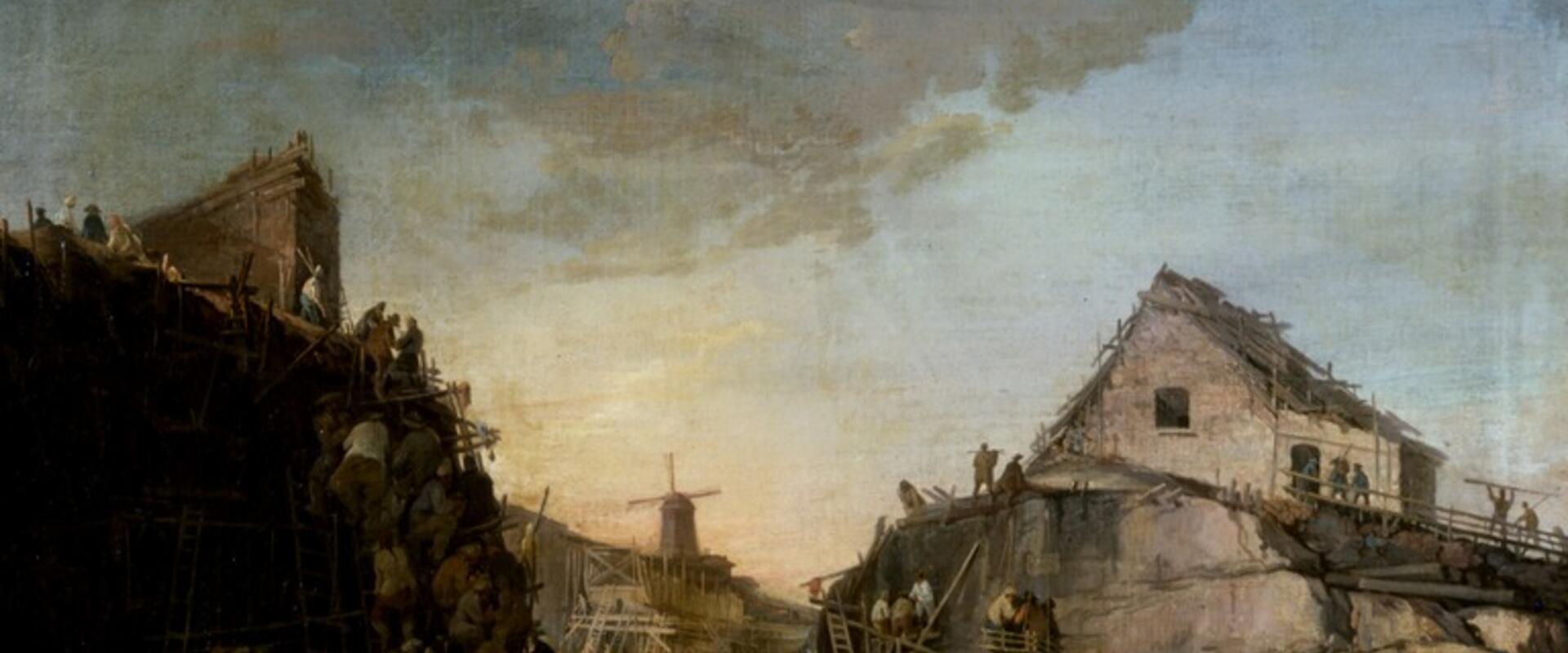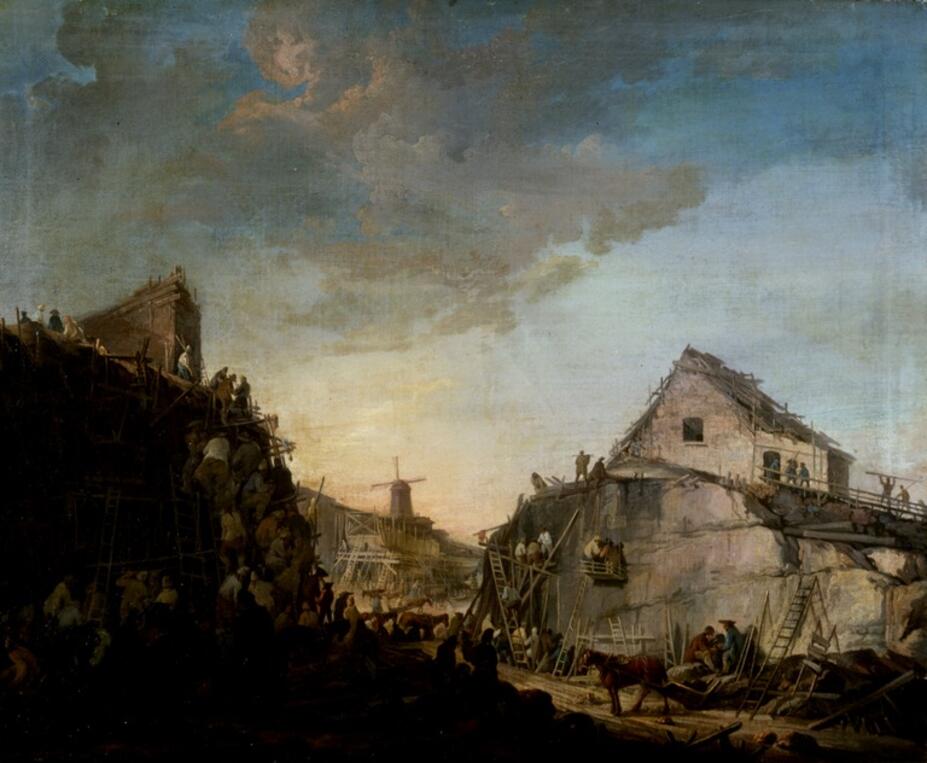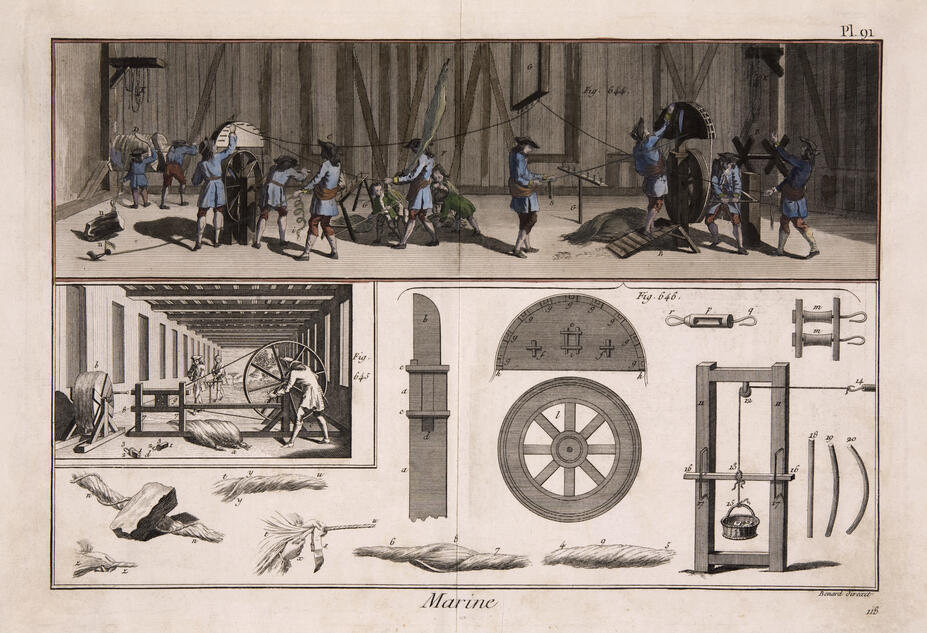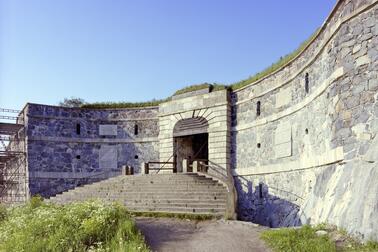The Viapori fortress and shipyard were quarried using muscle power and gunpowder on an almost uninhabited island. A painting by Elias Martin of the Viapori shipyard building site on a hot afternoon, possibly in July. The sun is shining on the site from the west. It has already been a long day, as the work was started in the early hours of the morning when it was still cool. Men are cutting stone and carrying boulders or transporting them in wheelbarrows. The work was hard on people and animals, but more than that – if the painting is to be believed – it was dangerous. Occupational safety was non-existent. The shipyard scaffolding seems extremely flimsy.
It is as if the artist specifically wanted to depict this aspect of the site. The scaffolding consists of long, thin poles with platforms at each end and several people on them. The painting suggests that there must have been a large number of accidents. Accidents were not recorded for historians but for pensions and exemptions, which meant that the description of the nature of the accident was vague or there was no description at all.
Who were the builders of Viapori?
Soldiers and vagrants were free labour for the Crown, without whom the fortress could not have been built. There were two groups of soldiers in Viapori. Most of them were tenement soldiers, who farmed their small tenements in the countryside. The second group was the mercenaries, i.e. men who joined the army for pay. The Queen Dowager’s Life Regiment (Änkedrottningens livregemente) was a regiment of such mercenaries in Viapori. Those in penal servitude and vagrants formed their own group. According to Tuula Rekola, who has studied the matter, people were classified as vagrants by a decision of the governor after having been questioned. They were necessarily not criminals, just unemployed and “debauched”. Naturally, debauchery could be defined in many ways.
The Viapori building site marked the start of the use of forced labour as a form of punishment, as there were no suitable sites or facilities before that. In 1804, a special workhouse was set up in Viapori for penal servitude. Female vagrants were also sent to Viapori, but most of them went to Turun kehruuhuone prison in Turku, established in the 1730s. Romanies (Zigenare) were also forced to work in relatively large numbers. Traditionally, many Romani had joined the army, because it gave them access to “legal protection”, i.e. protected them from being classified as vagrants. In 1805, a ban on the recruitment of Romani was imposed, which resulted in them being dismissed from the army and sent to workhouses. There were fewer convicted prisoners than soldiers. For example, according to Sampsa Hatakka, in 1805 there were 239 prisoners, while the total population of the fortress at the time was about 4,500.
Child labour was also used for rope making and in the city’s “plantations”, for example. Commandant Augustin Ehrensvärd had a tobacco plantation that used child labour at his mansion in Herttoniemi. Today, the site is an allotment garden, which you can see on the left between Kulosaari and Herttoniemi when taking the metro eastwards.
Viapori required a large part of the kingdom’s military power. In 1750, 37% of the soldiers in the Swedish army were posted to work in various parts of the kingdom, most of them in Viapori. Such a large sudden flux of immigration and the need to accommodate thousands of soldiers created major logistical problems for the Crown and the small city of Helsinki. The troops were housed in cramped barracks, the first of which were completed as soon as the building works began in 1748 in Ullanlinna and on the island of Siltasaari, and then on the island of Länsi-Mustasaari in 1757–1761. These were not enough, and soldiers were also housed with the city residents – in an urban versions of billets – or in the countryside in traditional billets. During the summer months, some tenement soldiers lived in tents. Prisoners and vagrants were housed in the fortress prison. The close interaction between civilians and soldiers militarised Helsinki, which began to develop into a military city.
Tenement soldiers and mercenaries were an important and, in a way, free resource for the Crown, as well as a skilled and permanent reserve of manpower. Tenement soldiers were a disciplined and reliable workforce. In addition to quarrying, soldiers were used as loggers, as a large volume of timber was required for the stone fortress and its dockyard. Craftsmen were also needed in the urban community that Viapori had become. Daniel Djurberg, a geographer at the time, considered Viapori as one of Finland’s cities. According to in-depth research by British J. E. O. Screen, the men in the Queen Dowager’s Life Regiment at Viapori came from a wide variety of occupations, but there were especially many cobblers, carpenters, blacksmiths and tailors. The range of occupations was wide, including a dancing teacher, a milliner and a waitress.
Working on the fortification building site was dangerous. Diseases were the main threat, as they spread in the cramped conditions, but there were also accidents. Nobody knows how many in total, as they were not systematically recorded. However, there are scattered historical records of accidents from which it is possible to deduce what kind of accidents took place and what kind of injuries were sustained.
Historian Heikki Vuorimies has studied mortality at the Viapori fortress building site. One ailment caused by manual labour could clearly be seen, namely hernias. This was because the men had to lift heavy loads without any mechanical aids. A hernia was a typical injury for the working class of the pre-modern era. Other injuries were caused by flying boulders from blasting. Matti Crantz, a soldier from Keuruu, was injured during blasting. Perttu Ståhlfot from Muurame was caught under a falling wall when the Stiernstedt bastion collapsed. He was so badly injured that he was no longer fit for service, Heikki Vuorimies states in his research.
Literature
Screen, J. E. O. The Queen Dowager’s Life Regiment in Finland 1772–1808. Studia Historica 81. Helsinki 2010.



